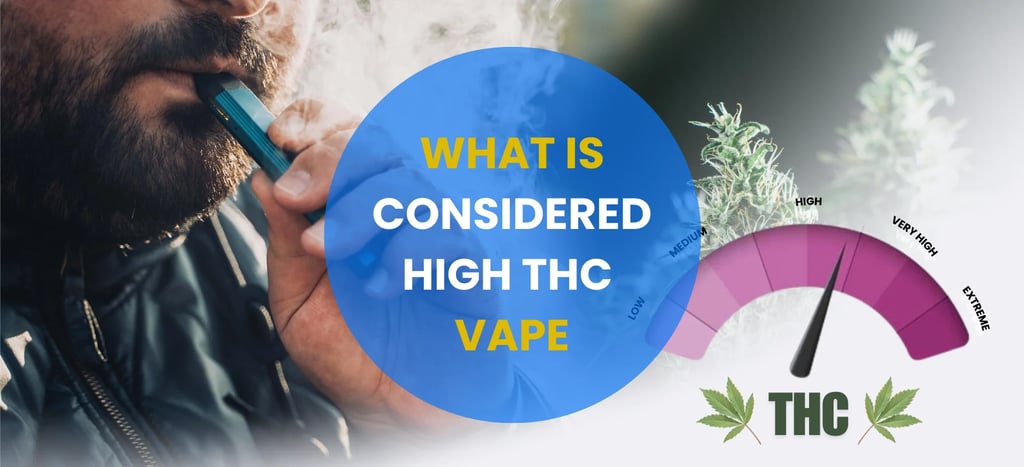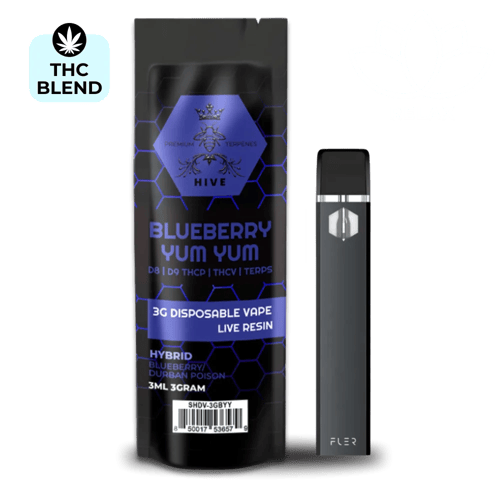
What is Considered High THC Vape?
What is the Average THC % for Hemp and Cannabis Products in the US?
THC percentage is a critical barometer in your choice and satisfaction in your vaping experience. THC % refers to how much THC is present in THC cartridges. Over the past several decades, THC percentages have been steadily on the rise.
This trend reflects significant changes for the cannabis industry and the vape consumer. Let’s take a look at the reasons why THC percentages have increased and how you can leverage this information to make an informed decision when buying disposable THC vape pen.
Historical THC Percentages of the Growing Cannabis Industry
When cannabis first got popular in the U.S. during the 1960s and 1970s, the average THC percentage in cannabis products (both recreational cannabis and medical marijuana products) was quite low compared to today’s. A cannabis flower grown during this period typically contained THC levels ranging from 1% to 3%. Although it is relatively low, such a percentage of THC was often regarded as a high THC percentage.
The modest THC content was due to the limitations faced by cannabis growers back then in terms of breeding different cannabis strains and the lack of advanced cultivation methods available at the time.
By the late 1990s and early 2000s – things had changed. The average THC percentage increased to between 5% and 8%. This rise was driven by a host of reasons, including: improvements in agricultural practices, consumer demand of higher THC levels, farmers enhancing the potency of cannabis flowers, and relaxed regulation.
Modern THC Percentage Chart

Today, human ingenuity, technological advancements in extraction methods and new cross breeding techniques of different strains, the average THC percentage among different THC products has witnessed a substantial increase.
This significant rise can also be attributed to the legalization of cannabis, which has paved the way for more refined and potent products to enter the market.
Vape Cartridges Products
Vape cartridges and pens vary significantly in THC content. This percentage of THC is largely dependent on the type of THC oil used.
THC distillate vape cartridges, which are designed to concentrate as much THC as possible by stripping away other cannabinoids and terpenes, typically contain between 85% and 90% THC.
Conversely, live resin cartridges, which aim to preserve the plant’s natural elements to offer a fuller range of effects, have a THC percentage that usually falls between 65% and 95%. The broad range accounts for the different extraction methods and the quality of the starting material.
THC Flowers
The THC percentage in a cannabis flower will range from 10% to 30%, with the average being around 20%. When you look at a dispensary menu, you’ll notice that most strains fall within this range.
Strains that possess around 10% of tetrahydrocannabinol are treated as low potency. However, it is often balanced with higher CBD levels and terpene profiles. On the other hand, a particular strain of a cannabis plant may have a higher THC percentage, above 25%.
THC Concentrates
Cannabis concentrates typically are blessed with the highest percentage of THC. These products’ THC percentages can reach a whopping 65% to 95%, depending on the specific product and how the manufacturer extracts the THC from the plant.
Live resin generally falls at the lower end of the spectrum, while a THC distillate, having more THC, has the highest THC percentage and is at the top of the spectrum. The other types of concentrates with in-between THC levels would be shatter, crumble, wax, diamonds, and budder.
THC Edibles
THC content of edibles typically comes in precise dosage measurements. Edibles are typically infused with a strong cannabis concentrate, and the effect could last for several hours as the edible needs to flow through the digestive tract before it enters the blood stream.
What Factors Influence THC Percentage in Vaping Devices?
Extraction Process
Companies that specialize in producing high-quality vapes with high THC concentration utilize innovative methods to ensure their products are both potent and safe for consumers. Stirling CBD belongs to such a class of CBD brands.
High-THC pens require meticulous extraction methods to maximize THC concentration while preserving the integrity of the cannabis compounds.
- CO2 extraction: This approach uses supercritical CO2 to pull cannabinoids and a rich terpene profile from the hemp or cannabis plants. CO2 extraction is known for producing a clean, high-potency product since it can isolate specific compounds without leaving harmful residues.
- Solvent-based extraction: As implied by the name, this extraction methodology includes the use of specific solvents such as butane and ethanol. These solvents effectively strip the plant material of its cannabinoids, resulting in a potent concentrate. However, it requires thorough purification to ensure no residual solvents remain.
- Solventless extraction: Stirling CBD uses a unique cavitation extraction method. Hemp biomass is placed in 33-degree distilled ice water to freeze and crystallize the trichomes. An impeller spinning at 22,000 RPM creates microbubbles that burst upon hitting the trichomes, releasing their compounds. The mixture is then filtered through a 40-micron screen, yielding the true essence of pure cannabinoids for the final extract.
Cannabinoid Content
To maximize the effects of your vaping session – it is crucial you select THC liquids made from top-tiered strains. Strains such as Durban Poison, Animal Cookies, Blueberry Yum Yum, Pineapple Express, Purple Punch, and Thin Mint are renowned for their entourage effect and potency.
Vaping these specific strains provide several key advantages:
- Enhanced potency: THC cartridges and pens with high THC percentages guarantee that the device has a substantial amount of THC. Thus, you are guaranteed a more intense high.
- Flavor and Aroma: Vape pens are able to retain their unique flavors and aromas in the vape form. Sometimes essential oils are added to further enhance their effects.
- Efficiency: Vaping can be more efficient in delivering THC to the bloodstream compared to smoking, making the high feel stronger and more immediate.
Concentration of THC
When choosing the perfect weed pen, it’s essential to consider the THC concentration present in the e-liquid. Vapes boasting high THC levels generally exhibit a ratio of 50% or higher, while those with a THC ratio of 10% or below are categorized as low-THC pens. These variances significantly impact the strength, psychoactive outcomes, and therapeutic advantages of the e-juice. A greater THC concentration results in more noticeable alterations in cognition, making such products favored by numerous cannabis aficionados for their robust and lasting medicinal attributes.
On the other hand, some individuals may prefer vapes with lower THC levels for a gentler impact or a more moderate experience. Understanding these variations is crucial for selecting a pen that aligns with individual preferences and desired experiences.
Quality of the Vaping Hardware
With the surge in popularity of e-cigarettes, vaping devices have become increasingly prevalent in the market. These devices are typically categorized into two main types: open-system and closed-system vapes.
An open-system vape allows users to manually fill their cartridges or tanks with their desired liquid mixture, whether it be THC oil or nicotine-based liquids. Smoking cannabis using this type of device offers greater flexibility regarding temperature control, THC concentration levels in the e-liquid, and flavorings and terpenes.
Additionally, vaping at higher temperatures can often intensify the effects of THC. On the other hand, closed-system vapes come pre-filled with a specific liquid blend that users cannot refill. While these closed-system devices offer convenience, they provide less control over THC ratios compared to open-system devices. The quality of the vaping hardware, whether open or closed-system, plays a significant role in determining the THC percentage in vapes and the overall vaping experience.
THC: Cannabis Plant vs. Hemp Plant
Cannabis and hemp plants are frequently mistaken for one another, although they may have the same strain. However, they differ considerably regarding chemical makeup, applications, and legal classification. Both belong to the Cannabis Sativa species and encompass over 540 compounds, including cannabinoids (Cannabidiol) and THC (tetrahydrocannabinol). The key difference between these plants is the varying levels of these cannabinoids.
Chemical Composition
Cannabis (Marijuana)
- Contains higher levels of THC and lower levels of CBD.
- THC is the psychoactive component responsible for the “high” associated with marijuana use.
- Used predominantly for recreational and medicinal purposes due to its psychoactive effects.
Hemp
- Contains higher levels of CBD and only trace amounts of THC (less than 0.3% by law).
- CBD is non-psychoactive and is often sought for its potential therapeutic benefits without the high.
- Primarily used for industrial purposes, such as producing fibers, textiles, and various CBD products.
Benefits and Side Effects of CBD
Despite the source, whether derived from marijuana or hemp, CBD offers the same potential benefits and side effects. The benefits include pain relief, reduction of anxiety and depression, and potential neuroprotective properties. Common side effects may include drowsiness, diarrhea, changes in appetite, and irritability. The therapeutic effects and side effects of CBD remain consistent irrespective of its source because its chemical structure does not change.
Extraction and Production
Hemp is the preferred source for extracting CBD due to its higher CBD content and minimal THC presence. This makes hemp-derived CBD products more lucrative and easier to produce, as they require less processing to remove THC. Additionally, using hemp as a source for CBD extraction minimizes legal complications and ensures compliance with regulatory standards.
Legal Status
The legal status of CBD products is a major differentiator between marijuana and hemp:
Hemp-derived CBD
The 2018 Farm Bill legalized hemp and hemp-derived products across most of the United States, provided they contain less than 0.3% THC. This has led to the widespread availability of hemp-derived CBD products in the market.
Marijuana-derived CBD
Remains under stricter regulations due to higher THC levels. In states where recreational use of marijuana is illegal, the DEA classifies all marijuana-derived CBD products as Schedule I drugs. These products are subject to more stringent regulatory scrutiny and legal restrictions.
For anyone looking to enhance their understanding of cannabis potency, a THC percentage chart provides essential guidance for safe and enjoyable consumption.
What Constitutes a Low THC Vape?
For those seeking a gentler and more controlled experience, low THC vapes are an excellent option. These devices typically contain THC concentrations below 10%, offering mild psychoactive effects. Ideal for beginners or users with low tolerance, they deliver subtle relaxation while maintaining mental clarity. Additionally, low THC vapes are often paired with higher CBD content for a calming entourage effect, making them popular for therapeutic use.
Frequently Asked Questions
What percentage of THC is legal?
When purchasing cannabis items from a recreational dispensary, there usually isn’t a specified THC percentage that qualifies as legal. However, restrictions on daily purchase amounts vary by state, aiming to manage cannabis product consumption and distribution within legal boundaries. Conversely, hemp products sold outside dispensary settings, like those found in stores or online, must adhere to a stringent legal limit for THC content. Federal guidelines dictate that hemp items must contain under 0.3% THC to remain lawful while maintaining a higher CBD percentage. This regulation guarantees that products derived from hemp maintain minimal THC levels, reducing the likelihood of psychoactive effects commonly linked with marijuana use.
What constitutes a high THC pen?
A high-THC pen generally denotes a vaping item holding a notable amount of THC, the psychoactive substance present in cannabis. The determination of what constitutes “high THC” may differ based on individual tolerance thresholds and legal statutes. In regions permitting recreational cannabis use, high-THC pens might boast THC levels reaching 70-90% or beyond. Such potent concentrations can trigger robust psychoactive responses and are favored by seasoned cannabis consumers in pursuit of pronounced euphoria or therapeutic benefits.









